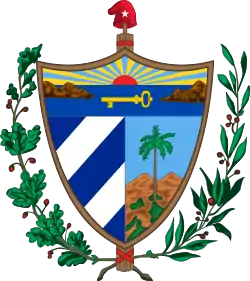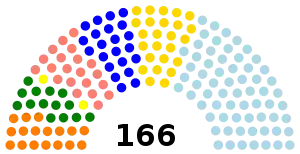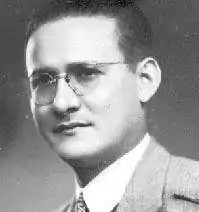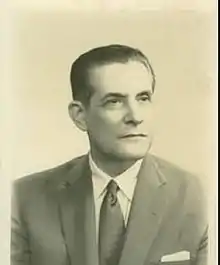1958 Cuban general election
General elections were held in Cuba on 3 November 1958.[1] The three major presidential candidates were Carlos Márquez Sterling of the Partido del Pueblo Libre, Ramón Grau of the Partido Auténtico and Andrés Rivero Agüero of the Coalición Progresista Nacional. There was also a minor party candidate on the ballot, Alberto Salas Amaro for the Union Cubana party. Voter turnout was estimated at about 50% of eligible voters.[2] Although Andrés Rivero Agüero won the presidential election with 70% of the vote, he was unable to take office due to the Cuban Revolution.[3]
| |||||||||||||||||||||
| |||||||||||||||||||||
| |||||||||||||||||||||
 |
|---|
| This article is part of a series on the politics and government of Cuba |
|
|
Background
The rebels had publicly called for an election boycott, issuing its Total War Manifesto on 12 March 1958, threatening to kill anyone that voted.[4]
Results
President
| Candidate | Party | Votes | % | |
|---|---|---|---|---|
| Andrés Rivero Agüero | Coalición Progresista Nacional | 428,166 | 70.40 | |
| Carlos Márquez Sterling | Partido del Pueblo Libre | 95,447 | 15.69 | |
| Ramón Grau | Partido Auténtico | 75,789 | 12.46 | |
| Alberto Salas Amaro | Partido Unión Cubana | 8,752 | 1.44 | |
| Total | 608,154 | 100.00 | ||
| Source: Bonachea & San Martin[5] | ||||
Chamber of Representatives
The 166 members of the Chamber of Representatives were elected; 85 for a four-year term 81 for a two-year term.[6]
 | ||
|---|---|---|
| Party | Seats | |
| Progressive Action Party | 65 | |
| Liberal Party | 25 | |
| Democratic Party | 22 | |
| Radical Union Party | 21 | |
| Partido Auténtico | 17 | |
| Partido del Pueblo Libre | 14 | |
| Partido Unión Cubana | 2 | |
| Total | 166 | |
| Source: Diario de la Marina.[6] | ||
Aftermath
Rivero Agüero was due to be sworn-in on 24 February 1959. In a conversation between him and the American ambassador Earl E. T. Smith on 15 November 1958, he called Castro a "sick man" and stated it would be impossible to reach a settlement with him. Rivero Agüero also said that he planned to restore constitutional government and would convene a Constitutional Assembly after taking office.[7]
See also
Notes
References
- "Todas las magistraturas de la Nación serán cubiertas mañana en 8,521 colegios electorales". Diario de la Marina. 2 November 1958. Retrieved 1 June 2018.
- Manuel Marquez-Sterling (2009) Cuba 1952-1959: The True Story of Castro's Rise to Power, Kleiopatria Digital Press
- Dieter Nohlen (2005) Elections in the Americas: A data handbook, Volume I, p217 ISBN 978-0-19-928357-6
- "Castro/M-26-7 Total War on Tyranny Manifesto 1958". Scribd.com. Retrieved 13 January 2021.
- Ramon L. Bonachea & Marta San Martin (2011) Cuban Insurrection 1952-1959, Transaction Publishers
- "Composición y clasificación de la Cámara en enero del 59". Diario de la Marina (in Spanish). 21 December 1958. Retrieved 1 June 2018.
- "154. Memorandum of a Conversation Between the Ambassador in Cuba (Smith) and President-Elect Rivero Agüero, Havana, November 15, 1958". Office of the Historian, Foreign Service Institute, United States Department of State. Retrieved 23 July 2020.
External links
- Cuba 1958 Articles
- Cuba, a country study, Federal Research Division Library of Congress
- Foreign Relations of the United States, 1958–1960, Cuba, Volume VI/Despatch From the Embassy in Cuba to the Department of State
- Elections and Events 1952-1959_San Diego
- Diario La Marina_1, 2 November 1958
- Diario La Marina_2, 2 November 1958
- 1958: Cuba's Last Election Day
- The 1940 Constitution of Cuba—(in English)
- The 1940 Constitution of Cuba—(in Spanish)


